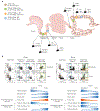Human intraepithelial lymphocytes
- PMID: 29674648
- PMCID: PMC6178824
- DOI: 10.1038/s41385-018-0016-5
Human intraepithelial lymphocytes
Abstract
The location of intraepithelial lymphocytes (IEL) between epithelial cells, their effector memory, cytolytic and inflammatory phenotype positions them to kill infected epithelial cells and protect the intestine against pathogens. Human TCRαβ+CD8αβ+ IEL have the dual capacity to recognize modified self via natural killer (NK) receptors (autoreactivity) as well as foreign antigen via the T cell receptor (TCR), which is accomplished in mouse by two cell subsets, the naturally occurring TCRαβ+CD8αα+ and adaptively induced TCRαβ+CD8αβ+ IEL subsets, respectively. The private/oligoclonal nature of the TCR repertoire of both human and mouse IEL suggests local environmental factors dictate the specificity of IEL responses. The line between sensing of foreign antigens and autoreactivity is blurred for IEL in celiac disease, where recognition of stress ligands by induced activating NK receptors in conjunction with inflammatory signals such as IL-15 can result in low-affinity TCR/non-cognate antigen and NK receptor/stress ligand interactions triggering destruction of intestinal epithelial cells.
Conflict of interest statement
ADDITIONAL INFORMATION
Figures


References
Publication types
MeSH terms
Substances
Grants and funding
LinkOut - more resources
Full Text Sources
Other Literature Sources

